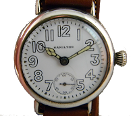First Wristwatch Movements:
0 – size 981, 983, 985 Caliber
6/0 – 986 Caliber
Wristwatches were known as “bracelet” models as opposed to pocket watches or timekeepers.
Hamilton “Wristwatches for Men” – the name used to identify their four Cushion style bracelets..
History shows that railroad companies had put time standards in place long before journalists purported that Webb C. Ball started watch inspections. During a series of accidents in 1891, railroad did set new standards for watch manufacturers. To do business with the railroads a company had to
By 1917, Hamilton Watch Company held over a 56% share of the railroad market. Their 17 jewel pocket watches exceeded the varying standards for timepieces required of engineers and conductors by their employers. Hamilton’s market share was dizzying considering their many competitors. The dozens of other American watch companies could only compete for 44% of the market.
The company had difficulty meeting demand for its products. Management changed its business strategy, focused on what they did best – making watch movements – and left the choice of cases and dials to the jeweler. If a consumer wanted a Hamilton watch, the a jeweler would customize it for you by letting you choose the kind of case and dial you wanted. He would then put a Hamilton movement in it. It said Hamilton on the dial, but the jeweler “cased” it for his customers.
Railroad watches had plain white dials with Arabic numerals, the crown on top covered by the pendant and movements with 17 jewels, adjustable in five positions of the wrist and the most dependable components available at the time. AND railroads required their watches to be American made.
 |
Hamilton’s philosophy extended to their meager entry into the wristwatch market. With 56% of the watch market, the Lancaster based Hamilton consider wristwatches a bother to its business model. The company made some gestures and watches to the US Military during World War I.
According to the Catalogs, the Hamilton Wristwatch for Men first appeared in 1919. Officially, when the United States went to war in 1917, the Army supposedly turned to Hamilton for timekeeping needs. The Corps of engineers purchased 1,000 Hamilton pocket watches for the supervision of railroad operations in France. That’s not exactly the kind of requisition that can establish a company as the standard bearer.
Hamilton introduced its first wristwatch in 1917. They designed it to appeal to men entering World War I. That watch contained the 1 inch (0-sized) 17-jewel 983 movement. They originally designed the 983 for women’s pendant watches and released it in 1908. Production ceased in 1918 and totalled 6900 units. The Company placed the movement into service for one year. They never advertised it in any catalog. Rough estimates say that Hamilton cased 1500 of these watches.
Hamilton also produced a like number of 19 Jewel men’s watches between 1917 and 1918. The 985 movement also measured 1 inch (0-sized). Production for this movement totalled 5800 units between 1908 and 1918. Again, the designers produced this movement for women’s pendant watches. They never advertised this watch in any catalog either.
Hamilton produced the 981 movement, advertised in the 1919 catalog, for four years. It appears the Company produced it exclusively for their Wristwatch for Men. Hamilton wrote that they could not keep up with demand. Maybe that is true. Their serial numbers indicate that they produced 2200 units between 1919 and 1922.
Copyright 2006-2017 | All Rights Reserved



